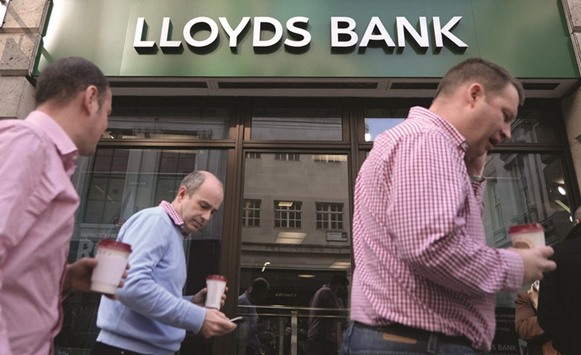An end to eight long years of government ownership is finally in sight for Lloyds Banking Group, though it took another £10mn ($12mn) on the way out, according to two people familiar with the matter.
Britain’s largest mortgage lender filmed a black horse galloping on a beach, built several websites and prepared space for 450 call centre employees anticipating a British retail share sale that now won’t happen, said the people, who asked not to be identified because the efforts weren’t public.
Chancellor of the Exchequer Philip Hammond last week opted to instead divest the nation’s 9% stake through smaller sales on the open market over the next 12 months, citing heightened volatility.
The wasted time and expense from abandoning the plan for a discounted retail offer is a relatively small price to pay to end state backing that has attracted scrutiny and ire. The government exit will also remove a major shareholder that’s subject to changes in political winds, such as the shift in Britain’s leadership following the Brexit vote.
“I was never a great fan of the retail offer,” said Eric Moore, who helps to oversee £2.5bn of assets at Miton Group in London including Lloyds shares. “If we can get the disposal completed, so much the better. It’s another step in their rehabilitation, and the government will get a better price getting on with it, rather than giving a discount.”
Former Chancellor George Osborne’s UK government officials planned to advertise the offer during prime-time slots on British TV including programmes such as talent show The X Factor and soap Coronation Street, which form the centrepiece of broadcaster ITV’s evening schedule. The plan was to mimic former Prime Minister Margaret Thatcher’s use of television advertising to sell shares in British Gas in 1986, which used the slogan “If you see Sid, tell him,” and became famous for its effectiveness in spreading word of the sale.
To help the government sell its holding, the bank agreed to foot some of the costs of the retail disposal and began drafting a prospectus for the stock offering, said the people with knowledge of the matter. The London-based lender also earmarked 450 desks at a call centre in Glasgow, Scotland, for additional staff to help smooth the sale, the people said. Government officials also wanted the stock to be made available in state- owned Post Office branches across the country, one of the people said.
The pain for Lloyds shareholders post-Brexit has gone well beyond unnecessary costs. Lloyds has slumped about 27% in London trading this year, shaving more than £13bn from its market value and making it the second-worst performer among major UK banks after Royal Bank of Scotland Group.
Lloyds declined to comment.
The government spent £20.3bn to rescue Lloyds in the midst of the 2008 financial crisis. The lender has since shrunk its balance sheet and returned to profitability, posting net income of £956mn last year.
Osborne previously sold shares in Royal Mail to 690,000 retail investors alongside a disposal to institutions in an initial public offering in 2013. The privatisation process was later criticised by the UK National Audit Office for undervaluing the 500-year-old postal company.
While Morgan Stanley will sell the shares below the government’s investment price, the Treasury said last week that it’s still able to recover its bailout cost. That’s because the UK once owned 43% of Lloyds and previously sold stock at a profit.
Hargreaves Lansdown chief executive officer Ian Gorham wrote to Prime Minister Theresa May asking the government to rethink its plans, after the firm, one of the UK’s biggest retail brokers, registered interest from 374,000 potential clients.
“Money from taxpaying working people bailed out Lloyds,” Gorham said in a statement. “Not giving them the opportunity to participate in its sale is disgraceful and patronising.”

Pedestrians pass a Lloyds Bank branch in London. Lloyds has slumped about 27% in London trading this year, shaving more than u00a313bn from its market value and making it the second-worst performer among major UK banks after Royal Bank of Scotland Group.
